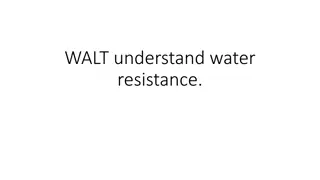Understanding a Series Circuit: Exploring Potential Difference, Current, and Resistance
Dive into the concept of a series circuit by visualizing it as a circular road with cars representing electrical charge flow. Learn about potential difference, current, energy transfer, and resistance in the circuit through relatable analogies and illustrations. Understand how a break in the loop or removal of a component impacts the flow of electricity. Explore the role of cells and bulbs in maintaining the circuit's operation.
Download Presentation

Please find below an Image/Link to download the presentation.
The content on the website is provided AS IS for your information and personal use only. It may not be sold, licensed, or shared on other websites without obtaining consent from the author. Download presentation by click this link. If you encounter any issues during the download, it is possible that the publisher has removed the file from their server.
E N D
Presentation Transcript
You can think of a circuit as a circular motorway a bit like the M25
Along this circular road, cars (called Q cars) slowly travel bumper-to-bumper all the way around a bit like the M25
A break in the road anywhere in the loop will mean all the cars stop moving.
If a bulb breaks or is taken out it creates a break in the circuit. This will stop all the cars, like a switch.
Understanding a series circuit Potential difference and Current
A petrol pump gives some energy to the cars, so they can drive round. The cell in an electrical circuit acts a bit like an energy pump.
We can measure the petrol difference before and after they visit the pump 6V V P D we call this the potential difference (measured in Volts). It tells us how much energy is being transferred to the circuit.
We can also measure how many Q cars cross a particular point in the road every second
The number of Q cars each second tells us the flow of cars A 3A this is the current (measured in Amps). It tells us how quickly electrical charge is flowing in the circuit.
Understanding a series circuit Resistance and Lamps
We can measure how many Q cars cross a particular point in the road every second
If the cars meet a resistance in the road, the cars will slow down
Because the cars are bumper to bumper 3 Ohms A 2A A 2A the resistance will slow down all the cars in the circuit. We measure resistance in Ohms.
The bigger the resistance, the slower the cars will go 6 Ohms A 1A The number of Q cars per second will get smaller The current (Amps) decreases.
An enterprising thief can take petrol from the cars as they slow down leaving just enough for the cars to get back to the petrol pump.
The thief uses the stolen petrol to burn in a barrel this gives out light and heat.
by stealing petrol, the thief takes some energy from the cars as they pass like a lamp in a circuit.
6V V P D 6V we can measure how much energy is taken by measuring the petrol difference before and after the cars pass the thief.
If there are two thieves, they will have to share the petrol they steal from the cars as they pass they have to leave enough petrol for the cars to get back to the pump.
3V V P D 6V each thief can only take half as much petrol, so his fire burns less bright. The energy transferred to each bulb will be halved.
6V 6V 6V 6V we could add another petrol pump, to give the cars more energy. This means each thief can take more petrol from the cars again. So the bulbs will be brightly lit again.
A 3A We can measure the flow of cars with one bulb.
A 1.5 A each extra bulb creates more resistance and will slow down the flow of cars. Reducing the current.
A break in a loop stops cars from moving in that loop but they can use the other loop to travel back to the pump.
But, a break that prevents cars getting to the pump will stop all of the cars in the circuit.
Understanding a parallel circuit Current and Resistance
All the cars leave the petrol pump 3 Ohms 3 Ohms Loop A A 2A Loop B The traffic cop will see the full number of cars per second (e.g. current 2A)
At the junction, the road splits and half the cars go along each loop. 3 Ohms A 1A 3 Ohms Loop A Loop B The traffic cop will see half the number of cars per second in loop A (e.g. current 1A)
The other half of the cars along the other loop 3 Ohms 3 Ohms Loop A A 1A Loop B The traffic cop will see half the number of cars per second in loop B (e.g. current 1A)
All the cars must come back to the petrol pump 3 Ohms 3 Ohms Loop A A 2A Loop B The traffic cop will see the full number of cars per second again (e.g. current 2A)
Some loops may have more resistance than others Cars prefer to take roads with less resistance
If one loop has more resistance than another 3 Ohms 6 Ohms Loop A Loop B The cars will still divide up between the two loops, but more will travel along the loop with less resistance.
All the cars must travel via the pump 3 Ohms 6 Ohms Loop A 3A A Loop B The traffic cop measures 3 Q cars per second; a current of 3 Amps
If loop A has half the resistance of loop B 2A 3 Ohms A 6 Ohms Loop A 3A A Loop B then for every 2 cars per second that travel along loop A
If loop A has half the resistance of loop B 4 Ohms 1A 8 Ohms Loop A A 3A A Loop B only 1 car per second will travel along loop B.
2A 4 Ohms A 1A 8 Ohms Loop A A 3A A Loop B Whichever loop they took - all the cars must travel back to the pump
Understanding a parallel circuit Voltage and Lamps
An enterprising thief can take petrol from the cars as they slow down leaving just enough for the cars to get back to the petrol pump.
6V Loop A 6V Loop B 6V With only one thief in each loop, each thief can take full amount of petrol from each car as they pass.
If there are two thieves in the same loop, they will have to share the petrol they steal from the cars as they pass they will only get half the petrol they would have on their own.
6V Loop A 3V 3V Loop B 6V Thieves in the same loop have to share petrol. The thief in his own loop gets all the petrol to himself.
Try some practice questions http://www.bbc.co.uk/bitesize/ks3/science/energy_electricity _forces/electric_current_voltage/quiz/q74171589/ http://www.twothirtyvolts.org.uk/education/revision- quiz/electric-circuits-11to14.html
Understanding circuits Formula triangles
The energy transferred by each Q car. The number of Q cars that pass a point each second. Roadworks slow the flow of cars.
The brightness of the bulb depends on how much energy is transferred each second that is how much petrol can the thief steal each second Power (Watts) = energy transferred each second (J/s) = current x voltage Brightness of the bulb = The number of cars passing each second x the amount of petrol the thief can take from each car.























